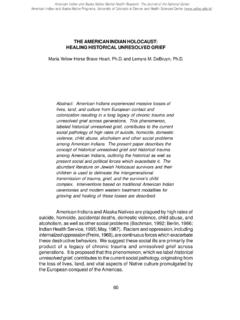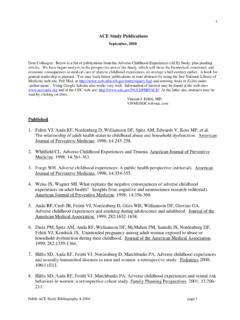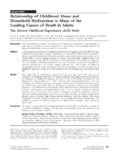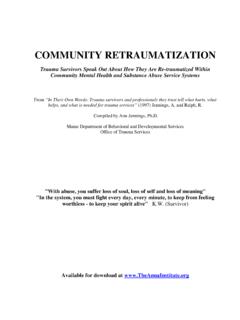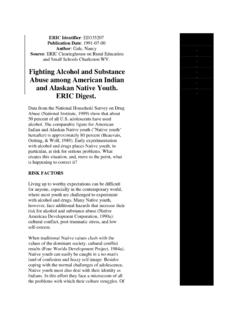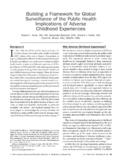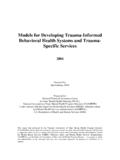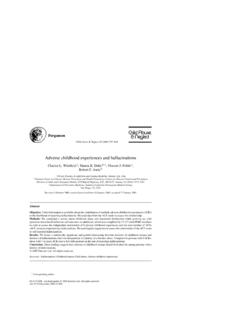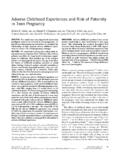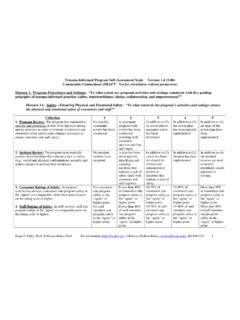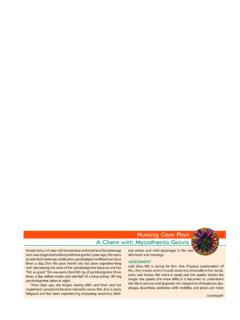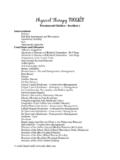Transcription of Cumulative Childhood Stress and Autoimmune …
1 Cumulative Childhood Stress and Autoimmune Diseases in AdultsSHANTAR. DUBE,PHD, MPH, DELISAFAIRWEATHER,PHD, WILLIAMS. PEARSON,PHD, MHA, VINCENTJ. FELITTI,MD,ROBERTF. ANDA, MD, MS,ANDJANETB. CROFT,PHDO bjective:To examine whether Childhood traumatic Stress increased the risk of developing Autoimmune diseases as an :Retrospective cohort study of 15,357 adult health maintenance organization members enrolled in the Adverse ChildhoodExperiences (ACEs) Study from 1995 to 1997 in San Diego, California, and eligible for follow-up through 2005. ACEs includedchildhood physical, emotional, or sexual abuse; witnessing domestic violence; growing up with household substance abuse, mentalillness, parental divorce, and/or an incarcerated household member.
2 The total number of ACEs (ACE Score range 0 8) was usedas a measure of Cumulative Childhood Stress . The outcome was hospitalizations for any of 21 selected Autoimmune diseases and 4immunopathology groupings: T- helper 1 (Th1) ( , idiopathic myocarditis); T-helper 2 (Th2) ( , myasthenia gravis); Th2rheumatic ( , rheumatoid arthritis); and mixed Th1/Th2 ( , Autoimmune hemolytic anemia).Results:Sixty-four percentreported at least one ACE. The event rate (per 10,000 person-years) for a first hospitalization with any Autoimmune disease in women and in men. First hospitalizations for any Autoimmune disease increased with increasing number of ACEs (p.)
3 05). Compared with persons with no ACEs, persons with 2 ACEs were at a 70% increased risk for hospitalizations with Th1,80% increased risk for Th2, and 100% increased risk for rheumatic diseases (p .05).Conclusions: Childhood traumatic stressincreased the likelihood of hospitalization with a diagnosed Autoimmune disease decades into adulthood. These findings areconsistent with recent biological studies on the impact of early life Stress on subsequent inflammatory words: Childhood abuse, traumatic Stress , Autoimmune diseases, Stress , inflammatory adverse Childhood experience;AD Autoimmune disease;Th1 T-helper 1;Th2 T-helper 2;CRP C-reactive protein;CRH corticoid releasing diseases (ADs) are a heterogeneous group of70 to 80 different inflammatory disorders affecting ap-proximately 3% to 8% of the population in the United States(1).
4 The prevalence of AD ( to million people) isreported to be steadily increasing (1,2). ADs occur when theimmune response damages tissues in the body; ADs are clas-sified according to the organ, tissue, or system targeted by theimmune response. Disease may present as early as the seconddecade of life, but typically peaks in the third to sixth decade(3). Infectious agents and environmental factors are mostcommonly cited as etiologic factors (4,5). Because many ADsbegin at a relatively young age and are chronic and treatmentsare palliative (2), they represent a significant personal andeconomic burden to individuals and their immune response has been classified as T-helper 1(Th1), T-helper 17 (Th17), or T-helper 2 (Th2) depending onthe release of interferon (IFN)- , interleukin (IL)-17, or IL-4from CD4 T cells.
5 However, both Th1 and Th2 ADs involvecell-mediated and antibody-mediated responses (5,6). ADscan be grouped according to the predominant immune mech-anisms as follows: Th1, mixed Th1/Th2, and Th2; AD clas-sically thought of as rheumatoid are classified as a subgroupof Th2 diseases. The risk for ADs may increase with age dueto an increasing Th2 response and increasing numbers ofautoantibodies (7).Conservative estimates indicate that approximately 80% ofthe individuals with AD are women (2) because the basicimmune response differs between men and women. For ex-ample, women respond to infection, immunization, or traumawith higher antibody production whereas inflammation is usu-ally more severe in men (6,8 11).
6 Sex differences in AD arealso likely to be linked to sex-specific differences in glucocor-ticoid responses to Stress because glucocorticoids decreasecell-mediated Th1-type immunity in response to acute Stress (7). Estrogen transcriptionally upregulates glucocorticoid lev-els in females whereas testosterone decreases glucocorticoidlevels in males (7,12 13).The long-term health effects of Childhood traumatic stressare well documented. For example, Childhood abuse, neglect,and related forms of household dysfunction increase the riskof substance abuse, mental illness, sexually transmitted dis-eases, suicide attempts, and other health outcomes, such asischemic heart disease (14 35).
7 To date, there have been fewstudies that examine the contribution of Childhood traumaticstress to the risk of developing an AD. A recent study byDanese and colleagues examined the association betweenchildhood trauma and C-reactive protein (CRP), a biomarkerof inflammation that may play a role in AD (36,37). Aftercontrolling for current Stress , they reported that childhoodmaltreatment was associated with elevated CRP levels inadults 20 years later, suggesting that Childhood maltreatmentindependently increases inflammation later in life (36).From National Center for Chronic Disease Prevention and Health Promo-tion( , , ), Centers for Disease Control andPrevention, Division of Adult and Community Health, Atlanta, Georgia;Department of Environmental Health Sciences ( ), Bloomberg School ofPublic Health and Department of Pathology, School of Medicine, JohnsHopkins University, Baltimore, Maryland; and the Department of PreventiveMedicine ( ), Southern California Permanente Medical Group (KaiserPermanente), San Diego, correspondence and reprint requests to Shanta R.
8 Dube, Centersfor Disease Control and Prevention, National Center for Chronic DiseasePrevention and Health Promotion, Division of Adult and Community Health,4770 Buford Highway, , MS K-50, Atlanta, GA 30341-3717. for publication May 16, 2008; revision received July 28, findings and conclusions in this article are those of the authors and donot necessarily represent the views of the Centers for Disease Control Adverse Childhood Experiences Study was supported under coopera-tive agreement #TS-44 to 10/11 from the Centers for Disease Control andPrevention through the Association of Prevention Teaching and Research anda grant from the Garfield Memorial Fund.
9 This study was also partiallysupported through a sole source contract (#200-2005-M-13275) with theKaiser Foundation Research Institute. Dr. Fairweather is supported by GrantR01 HL087033 from the National Heart, Lung and Blood : Medicine 71:243 250 (2009)0033-3174/09/7102-0243 Copyright 2009 by the American Psychosomatic Society Published Ahead of Print on February 1, 2009 as longitudinal data from the Adverse Childhood Ex-periences (ACEs) Study, we created an ACE Score, using aninteger count of eight interrelated and co-occurring (24,34,35)exposures of Childhood adversity, to measure cumulativechildhood traumatic Stress . The relationship between the ACES core and the risk of 21 different ADs as an adult wasexamined.
10 We hypothesized that as the Cumulative exposureto Childhood Stress and trauma increased the risk of develop-ing AD in adulthood would also PopulationThe ACE Study has been described elsewhere (14 35). More than 50,000adult members of the Kaiser Foundation Health Plan in San Diego, Californiaare evaluated annually at Kaiser Permanente s San Diego Health AppraisalClinic (HAC). All Health Plan members who visit the HAC complete astandardized evaluation that included assessment of health history, health-related behaviors, a clinical review of systems, and psychosocial evaluations(14). Health plan members who completed the standardized HAC evaluationduring 1995 to 1997 were eligible to participate in the ACE Study.
